Abstract
Various morphologies of magnesium carbonate hydrate had been synthesized without using any organic additives by carefully adjusting the reaction temperature and time during the talc carbonation process. At lower temperatures, magnesium carbonate hydrate was prone to display needle-like morphology. With the further increase of the carbonation temperature, the sheet-like crystallites became the preferred morphology, and at higher aging temperatures, these crystallites tended to assemble into layer-like structures with diverse morphologies, such as rose-like particles and nest-like structure. The reaction time had no effect on the crystal morphology, but it affected the particle size and situation of the crystal growth. X-Ray diffraction results showed that these various morphologies were closely related to their crystal structure and compositions. The needle-like magnesium carbonate hydrate had a formula of MgCO3·3H2O, whereas with the morphological transformation from needle-like to sheet-like, rose-like, and nest-like structure, their corresponding compositions also changed from MgCO3·3H2O to 4MgCO3·Mg(OH)2·8H2O, 4MgCO3·Mg(OH)2·5H2O, and 4MgCO3·Mg(OH)2·4H2O.
1 Introduction
Magnesium carbonate hydrate, as an important magnesia inorganic chemical product, has been widely used in various industrial fields (e.g., filter material, pharmaceuticals, cosmetic manufacturing, rubber industry, lithographing inks, and as precursors for high-purity magnesium oxide [1,2]). Magnesium carbonate hydrate is a class of chemical compounds, and the general formula can be expressed as xMgCO3·yMg(OH)2·zH2O (x = 1–5, y = 0–1, z = 1–8). Each pair of xyz values corresponds to a material. Each material has its own crystal type and micromorphology. It is generally accepted that the crystal type, micromorphology, and their properties are closely related, and different forms of particles sometimes give different particle properties even for the same substance [3,4]. So, the design and synthesis of magnesium carbonate hydrate with well-controlled morphology are very important.
There have been a large number of chemical methods invented to produce various morphologies of magnesium carbonate hydrate so far. For example, Gautier et al. [5] have studied the growth process of hydromagnesite by calculating its growth kinetics in aqueous solution from 25 to 75°C. Zhang et al. [1] have successfully achieved the magnesium carbonate whiskers by using magnesium salt and sodium bicarbonate solutions, while Guo et al. [6] have found an effective method to adjust the morphology of magnesium carbonate by the reaction of MgCl2 with Na2CO3 under the influence of polyacrylamide. Wu et al. [7] have developed a procedure to generate magnesium hydroxide nanoparticles in water-in-oil microemulsions. Wang et al. [8] produced needle-like nesquehonite by the reaction of MgCl2 with (NH4)2CO3 in supersaturated solutions. Mitsuhashi et al. [9] have developed a procedure to generate microtube hydromagnesite by the magnesium hydroxide carbonation. Yan and Xue [10] have prepared nest-like hydromagnesite spheres by a self-assembly of nanosheets in the hydrothermal process. Li et al. [11] have synthesized rose-like hydromagnesite spheres by reacting anhydrous magnesium sulfate and urea via a hydro-thermal method. Zhang et al. [3] have found that various morphologies of magnesium carbonate hydrate (including nesquehonite and hydromagnesite) can be synthesized by carefully adjusting the reaction temperature and pH value of the initial reaction solution in a MgO–CO2–H2O system during the precipitation process. Through the above analysis, chemical pure substance was the main raw material to produce magnesium carbonate hydrate. To our knowledge, few people have systematically investigated the production of magnesium carbonate hydrate by natural mineral.
Talc is a 2:1 type layered silicate mineral and is abundant in China. Talc shows great physical and chemical properties, which allows us to use it in many fields (e.g., as a filler material, porous material, for the pharmaceutical use, in cosmetics or rubber industry, ceramic [12,13,14,15,16,17,18]). This material is also magnesium-rich and can be used as a raw material to prepare magnesium-based chemicals to not only reduce the production cost but also achieve high-value use of talc.
In this study, the magnesium carbonate hydrate with different morphologies was synthesized by talc carbonation without using any organic additives. We systemically investigate the influence of reaction temperature and reaction time on the morphologies of magnesium carbonate hydrate. The preparation method reported herein showed a possibility for high-value utilization of the silicate mineral carbonation product for CO2 sequestration.
2 Experiment and methods
2.1 Material
Talc powders (SiO2 62.45; MgO 31.16; Fe2O3 0.63; Al2O3 0.08; TiO2 0.1, mass%) were prepared from pristine talc from Guangxi Province, China, by milling with an ignition loss of 5.21. The talc was mingled with some quartz, and talc was the dominating phase. Hydrochloric acid, magnesium chloride, and ammonia were used without further purification. The purity of industry-grade carbon dioxide was 99.9%. The talc powders used in the experiment were ground to less than 15 µm in size.
2.2 Synthesis
The acid-leaching experiment was performed by subjecting talc samples to the hydrochloric acid solution. Approximately 10 g of talc was placed into a 400 mL reaction vessel. A magnetic stir bar was used to ensure adequate mixing throughout the reaction. A hot-bath was utilized to maintain the desired reaction temperature.
The carbonation experiment was performed by subjecting ammonia and carbon dioxide to the acid leaching solution. Magnesium chloride (AR) was added to the acid leaching solution to increase the Mg2+ concentration to make it meet the experimental requirement (0.7 mol/L). Industry-grade CO2 was injected with a predetermined flow rate at normal pressure. A magnetic stir bar was used to ensure adequate mixing throughout the reaction. A hot bath was used to maintain the desired reaction temperature. After the desired reaction time, the mixture was aging in a hot bath without stirring at the predetermined temperature and time. Then, the mixture was cooled and filtered to separate the solids from the solution. The solids were then washed with distilled water until they reached a neutral pH, before being dried in an oven at 110°C for 24 h. Detailed experimental conditions for each set of carbonation experiments are listed in Table 1.
Conditions of magnesium carbonate hydrate prepared during talc carbonation
| No. | Carbonation temperature (°C) | Carbonation time (min) | Aging temperature (°C) | Aging time (h) | Products |
|---|---|---|---|---|---|
| 1 | 40 | 30 | 60 | 4 | Figure 2a |
| 2 | 50 | 30 | 60 | 4 | Figure 2b |
| 3 | 60 | 30 | 60 | 4 | Figures 1a and 2c |
| 4 | 80 | 30 | 60 | 4 | Figures 1b and 2d |
| 5 | 40 | 30 | 60 | 4 | Figure 3a |
| 6 | 40 | 60 | 60 | 4 | Figure 3b |
| 7 | 40 | 90 | 60 | 4 | Figures 1c and 3c |
| 8 | 40 | 120 | 60 | 4 | Figure 3d |
| 9 | 40 | 30 | 60 | 4 | Figure 4a |
| 10 | 40 | 30 | 70 | 4 | Figure 4b |
| 11 | 40 | 30 | 80 | 4 | Figure 4c |
| 12 | 40 | 30 | 100 | 4 | Figure 4d |
| 13 | 40 | 30 | 100 | 1 | Figure 5a |
| 14 | 40 | 30 | 100 | 4 | Figure 5b |
| 15 | 40 | 30 | 100 | 8 | Figure 5c |
| 16 | 40 | 30 | 100 | 12 | Figures 1d and 5d |
2.3 Data analysis
The composition of the sample was determined by X-ray fluorescence and chemical titration. Powder X-ray diffraction (XRD) measurements of the samples were conducted with a DX-2700 X-ray diffractometer using Cu Kα radiation (λ = 0.15406 nm) at a scanning ratio of 0.02 deg/s with a voltage of 40 kV at 40 mA. Scanning electron microscopy (SEM) was performed by a JEOL JSM-6360LV scanning electron microanalyzer with an accelerating voltage of 5 kV.
Ethical approval: The conducted research is not related to either human or animal use.
3 Results and discussion
3.1 Extraction of magnesium from talc
In a previous study [19], talc-to-enstatite and magnesite-to-periclase transformations were reported when the pristine talc was calcined at 890°C for 60 min. Leaching of magnesium from calcined talc was performed with a 3 mol/L HCl solution at 40°C for 90 min, with a solid-to-liquid ratio of 1:10. Most Mg2+ was leached from the thermally activated talc with HCl with a leaching rate up to 95.05%, which benefited the subsequent carbonation reaction.
According to previous experimental results, the reaction temperature and time are known to be important factors for mineral carbonation of magnesium ions. Throughout the carbonation experiment, the concentration of magnesium in the reaction solution, the volume of the reaction solution, the amount of ammonia, and CO2 flow rate were set to a stoichiometric value that was calculated in our previous study on mineral carbonation for wollastonite [20,21]; these values were 0.7 mol/L, 100 mL, 9 mL, and 200 mL/min, respectively. The following discussion focuses on the impact of reaction temperature and time on the crystal phase and morphology of carbonation products.
3.2 Production of magnesium carbonate hydrate with different morphologies
The morphology of these magnesium carbonate hydrate particles produced by talc carbonation was visualized by SEM, and the representative images are presented in Figure 1. As can be observed, the magnesium carbonate hydrate particles exhibited four different microscopic morphologies [22,23,24]. In Figure 1a, the needle-like particles were produced, and the axis diameter was in the range of 0.3–0.8 µm. As can be seen in Figure 1b, the particle displayed sheet-like morphology with a thickness of 40–60 nm. With the further change of reaction parameters, the sheet-like structure would transfer into different layer-like particles, such as rose-like (Figure 1c) and nest-like (Figure 1d) particles.
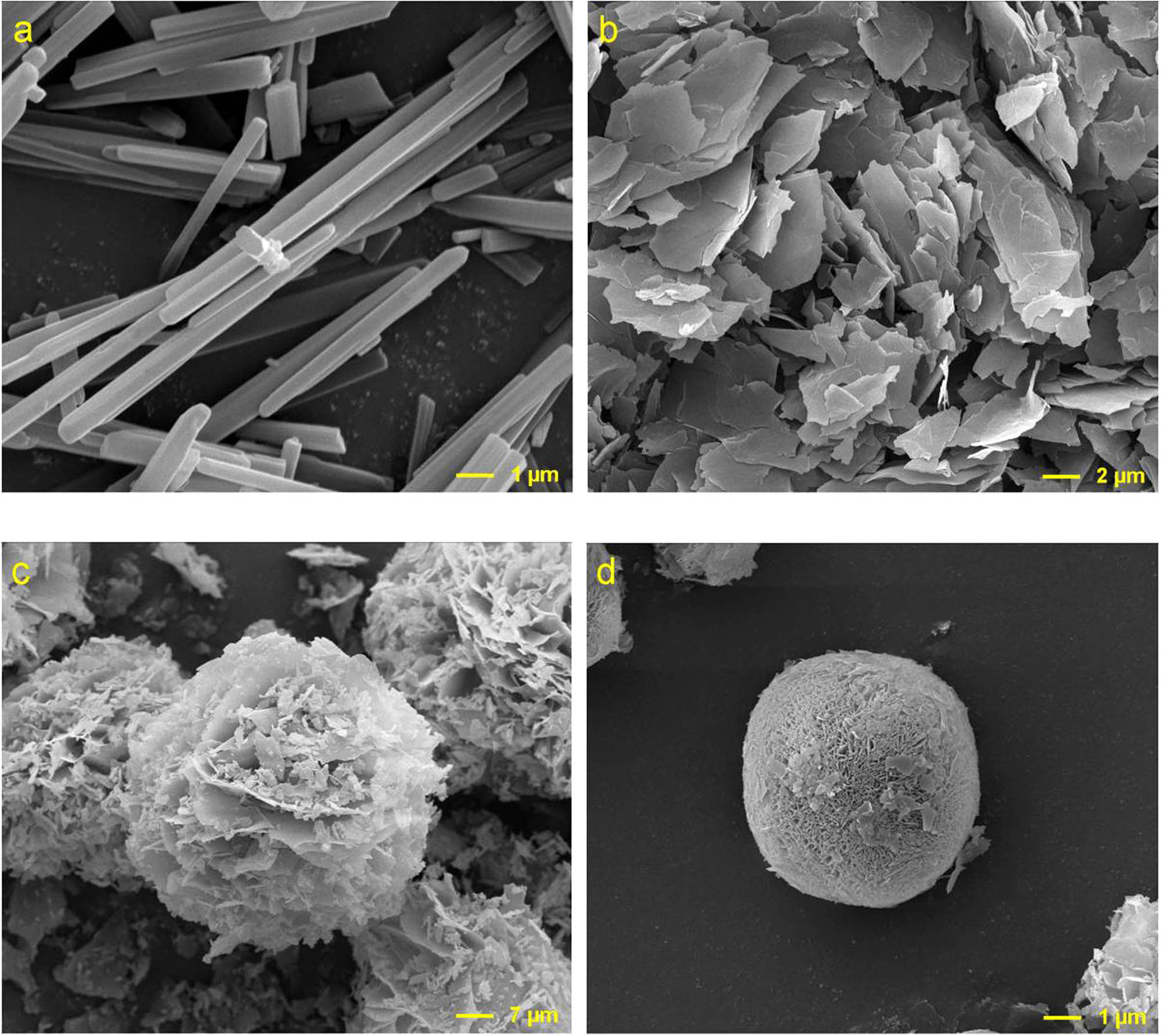
Typical SEM images for the magnesium carbonate hydrate particles during the talc carbonation: (a) needle-like, (b) sheet-like, (c) rose-like, (d) nest-like.
3.2.1 Effect of reaction temperature
As shown in Figures 2 and 3, these morphologies drastically change with the variation of the reaction temperature. When the carbonation temperature increases from 40 to 60°C, as shown in Figure 2a–c, the needle-like particles were produced, and the average length varies with the increase of the reaction temperature. When the reaction was carried out at 40°C, the length was in the range of 2–8 µm. With the increase of the carbonation temperature, the length gradually decreased, and it became 3–14 µm at 50°C. However, further increasing the temperature up to 60°C results in a slight increase of the length, and it became 2–18 µm. This case could be ascribed to the fact that high reaction temperature was more advantageous to the growth of crystals. With the increase of temperature, the viscosity of the initial solution gradually decreased, which accelerated the collision rate of the nuclei. A higher collision rate brought about a higher number of nucleated particles, so it was prone to produce smaller particles. When the temperature reached 60°C, the higher collision rate may also contribute to an increase in the probability of coalescence, and the particle size had a slight increase. This was in line with the predecessors’ research results [3]. After careful observation of these needle-like particles in Figure 2a–c, it was clear that the surface structures of these particles became much smoother with the increase of the carbonation temperature. When the carbonation temperature was up to 80°C, a great change in the morphology of the carbonation products took place. As can be seen in Figure 2d, the morphology varied to sheet-like particles with a thickness of 20–40 nm.
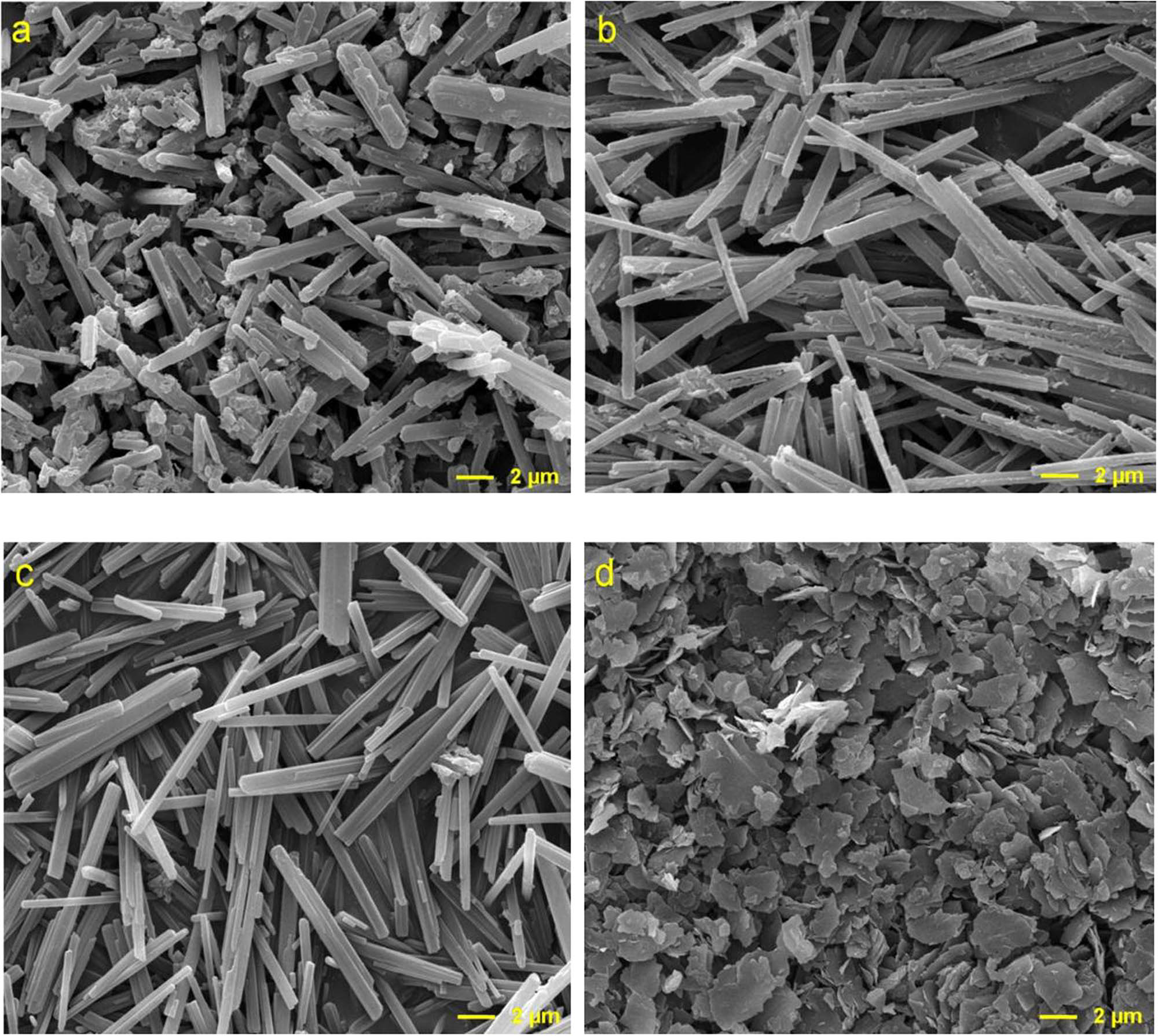
SEM images for the carbonation products with different carbonation temperatures: (a) 40°C, (b) 50°C, (c) 60°C, and (d) 80°C.
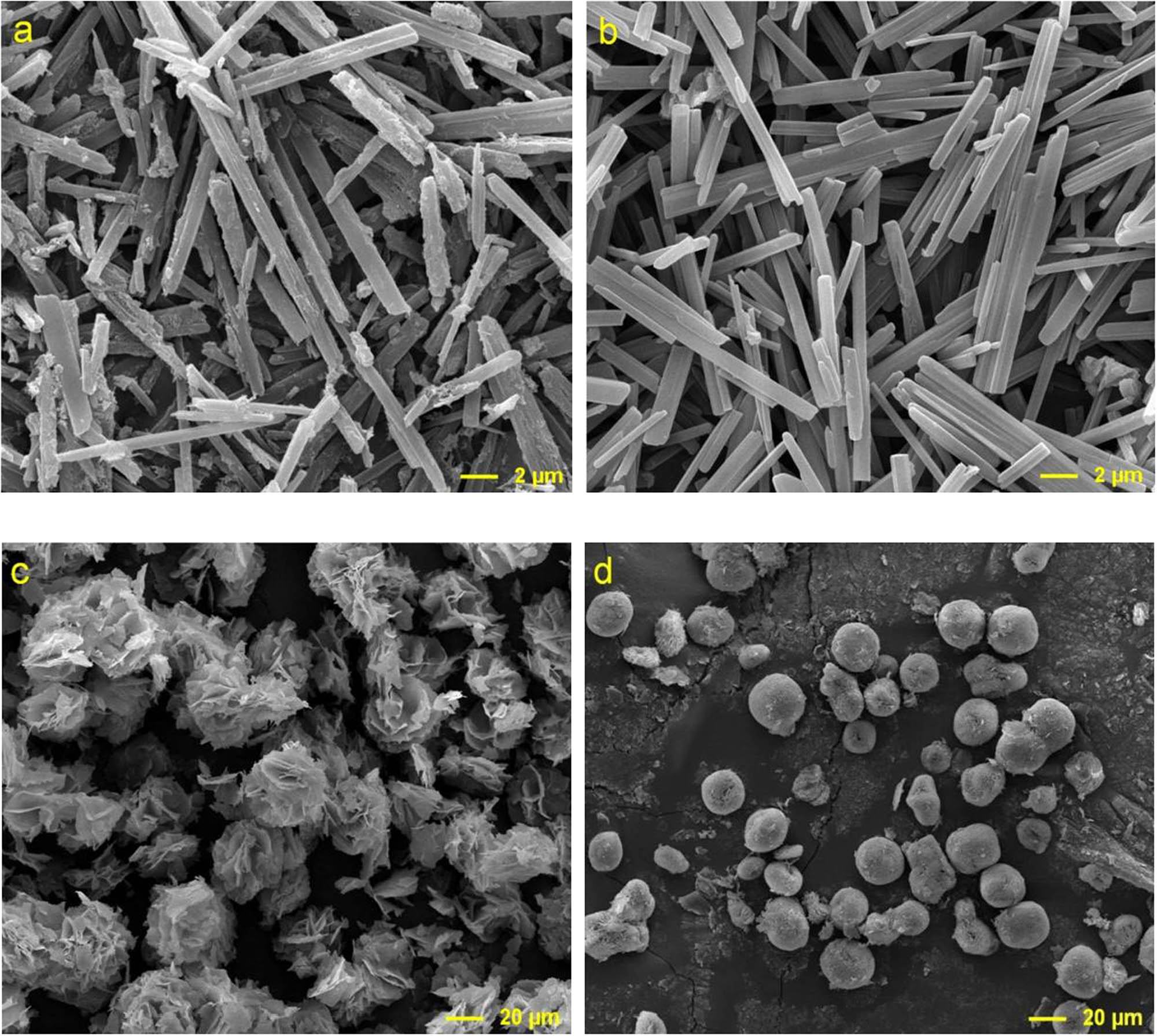
SEM images for the carbonation products with different aging temperatures: (a) 60°C, (b) 70°C, (c) 80°C, and (d) 100°C.
The aging temperature also played an important role in the morphology of the carbonation products. When the aging temperatures were 60 and 70°C, all the particles displayed needle-like morphology in Figure 3a and b. As shown in Figure 3c and d when the aging temperature was up to 80°C, the morphology varied from needle-like particles to the rose-like particles [11] with a diameter of 25–40 µm. With the increase of the aging temperature from 80 to 100°C, the particles were prone to display nest-like morphology with a diameter of 15–25 µm [25].
3.2.2 Effect of reaction time
The typical images of the reaction products produced at different carbonation times are shown in Figure 4. At different carbonation times, the particles all displayed a needle-like morphology, but the situation of the crystal growth was different with the extended reaction time, which is obvious in Figure 4a and d. This case could be ascribed to the fact that at a shorter carbonation time (such as 30 min), a small amount of carbon dioxide could dissolve into the solution, and the contact time between Mg2+ and CO32− was too short. So, the crystal was short and the surface was very coarse. With the increase of the carbonation time, the content of carbon dioxide in the solution increased gradually. It provided sufficient raw materials for the growth of MgCO3·3H2O. As a result, the growth of MgCO3·3H2O was getting better and better with the further progress of the reaction. At last, the particles formed needle-like morphology with a smooth surface and uniform diameter at the carbonation time of up to 120 min. The morphologies of the carbonation products produced at different aging times are shown in Figure 5. It had the same conclusion with carbonation time.
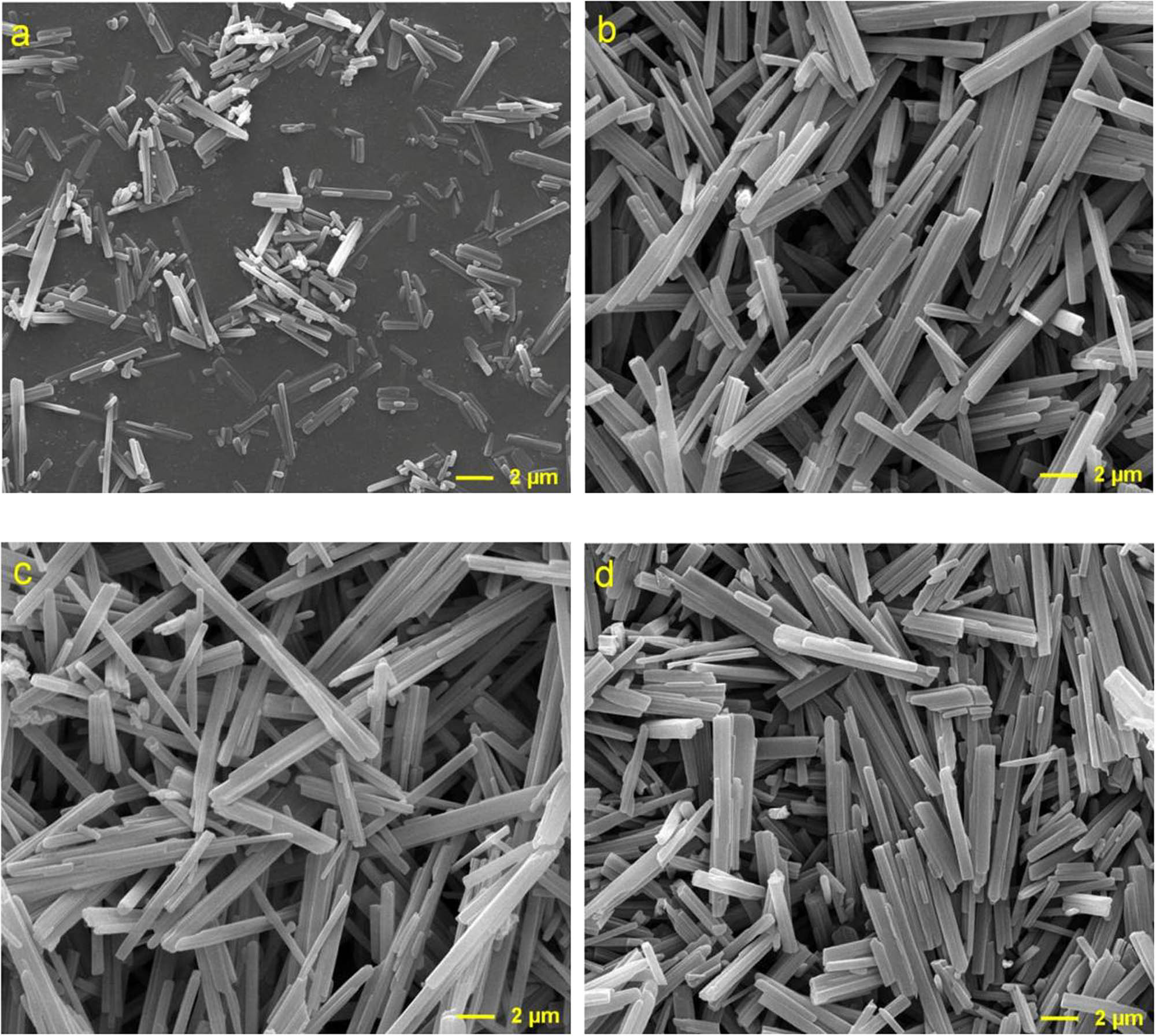
SEM images for the carbonation products from different carbonation times: (a) 30 min, (b) 60 min, (c) 90 min, and (d) 120 min.
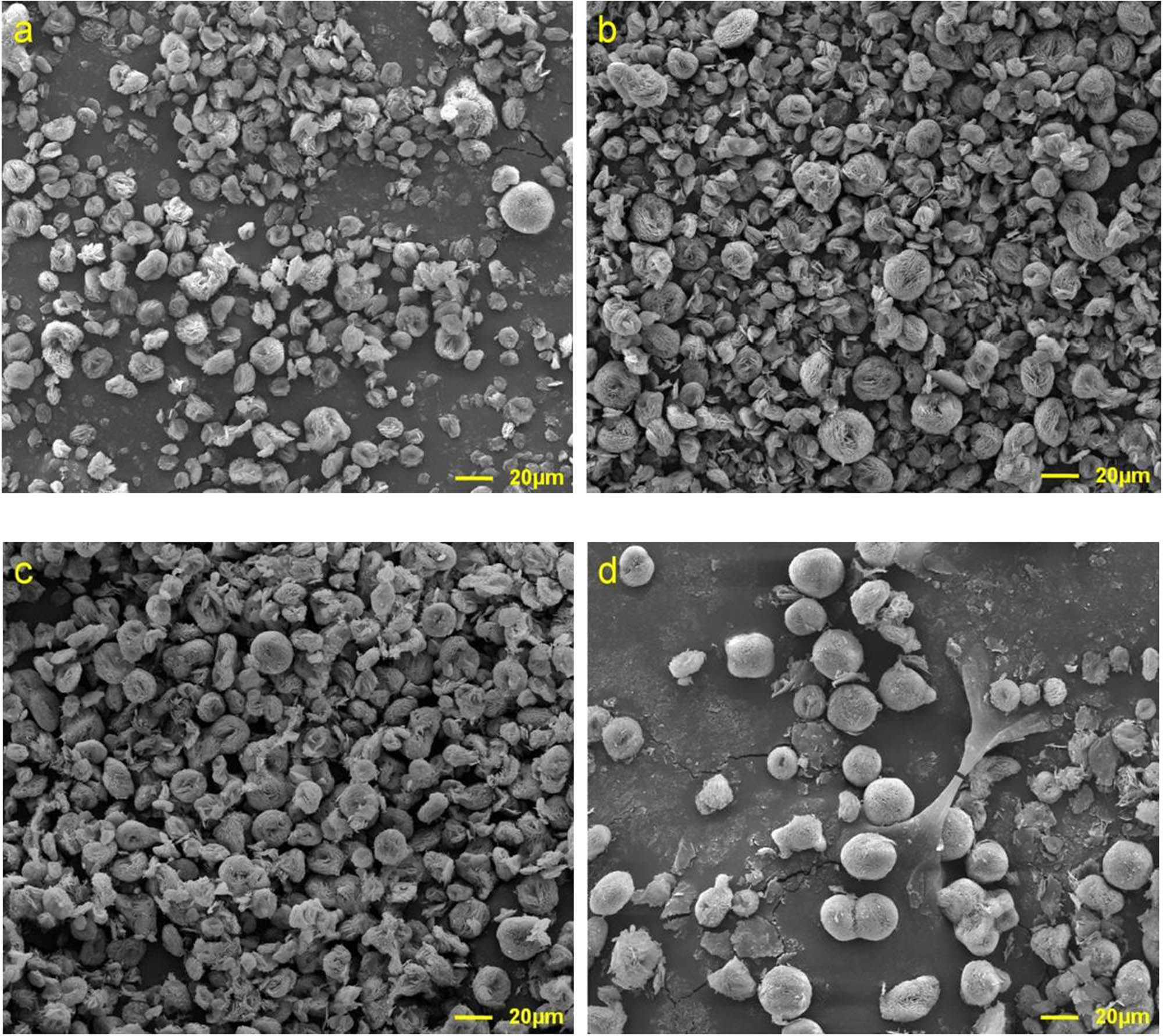
SEM images for the carbonation products from different aging times: (a) 1 h, (b) 4 h, (c) 8 h, and (d) 12 h.
3.3 Relationship between the crystal phase and micromorphology of magnesium carbonate hydrate
To better understand the morphology evolution with the variation of temperatures and reaction time, the crystal structure and compositional information of the carbonation product have been recorded by XRD. Figures 6–9 show the corresponding XRD results of these reaction products obtained from different reaction temperatures and time. It was obvious that the XRD patterns varied significantly with the increase of the reaction temperature. For the particles obtained with the carbonation temperature from 40 to 60°C (Figure 6a–c) and the aging temperature from 60 to 70°C (Figure 7a and b), all diffraction peaks in the XRD patterns can be indexed as the monoclinic structure of nesquehonite (MgCO3·3H2O) with unit cell parameters of a = 12.11, b = 5.37, and c = 7.70 Å and α = γ = β = 90°, which are in good agreement with the reported data (JCPDS Card 020-0669). Research about crystal structure suggests that MgCO3·3H2O formed a 1D chain-like structure by [MgO6] octahedral. Along the direction of the lattice plane (010), [MgO6] octahedral is closely linked by Mg–O. So, the growth of the lattice plane (010) is the fastest, and MgCO3·3H2O is prone to form chain-like structure along the direction and to display needle-like morphology [26]. With the increase of the carbonation temperature up to 80°C (Figure 6d), the XRD pattern underwent a great change. Nesquehonite was transformed into dypingite (4MgCO3·Mg(OH)2·8H2O, JCPDS Card 029-0857). Research about crystal structure suggests that the growth of 4MgCO3·Mg(OH)2·8H2O along (100) and (001) face is faster, and the crystal is prone to form 2D structure and to display sheet-like morphology. When the aging temperature was up to 80–100°C, the crystal phase of the reaction products was transformed into dypingite (4MgCO3·Mg(OH)2·5H2O, JCPDS Card 023-1218) and hydromagnesite (4MgCO3·Mg(OH)2·4H2O, JCPDS Card 025-0513), respectively (Figure 7c and d). Figure 8 provides a set of XRD patterns corresponding to the samples from different carbonation times. As can be observed, the only crystal phase was nesquehonite at different carbonation times. The intensity of the crystal diffraction peaks was gradually increased with an increase of the carbonation time, well consistent with the SEM results. The XRD results of the reaction products produced at different aging times are shown in Figure 9. The only crystal phase was hydromagnesite at different aging times. And the intensity of the crystal diffraction peaks was gradually increased with an increase of the aging time. These results suggested that the reaction products exhibit four different microscopic morphologies. The reaction products of the crystal phase for nesquehonite (MgCO3·3H2O) displayed needle-like morphology, and the products of the crystal phase for dypingite (4MgCO3·Mg(OH)2·8H2O) displayed sheet-like morphology. The reaction products of the sheet-like structure would transfer into different layer-like particles, such as rose-like and nest-like particles. The assembly process had something to do with the reaction temperature (including carbonation temperature and aging temperature).
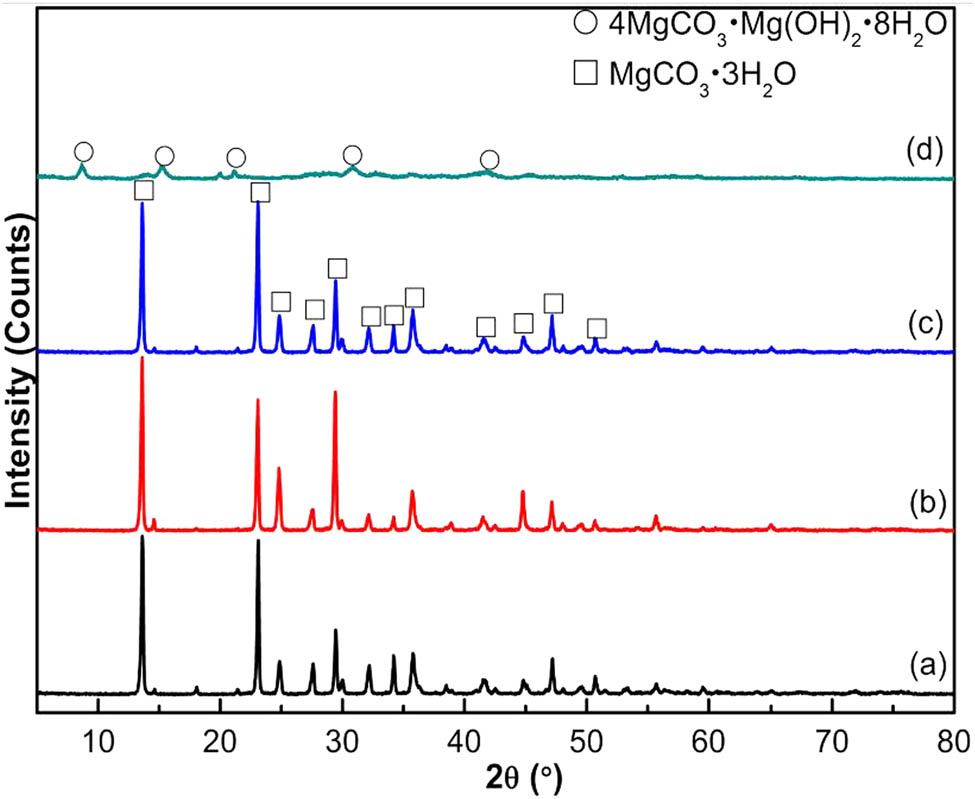
XRD patterns for the carbonation products with different carbonation temperatures: (a) 40°C, (b) 50°C, (c) 60°C, and (d) 80°C.
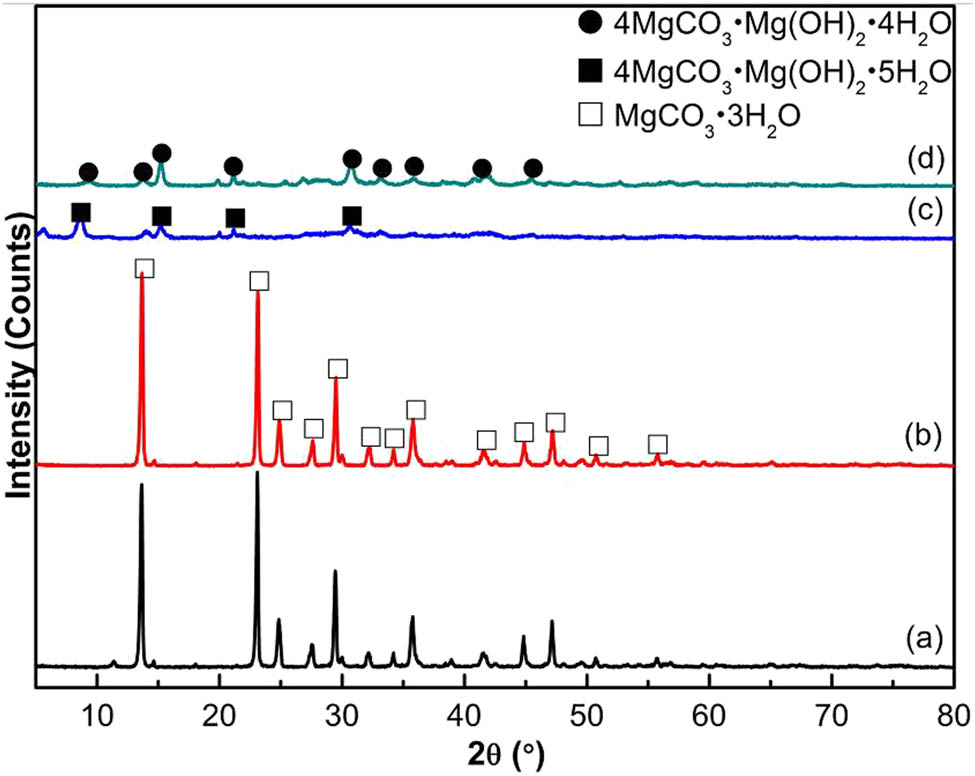
XRD patterns for the carbonation products with different aging temperatures: (a) 60°C, (b) 70°C, (c) 80°C, and (d) 100°C.
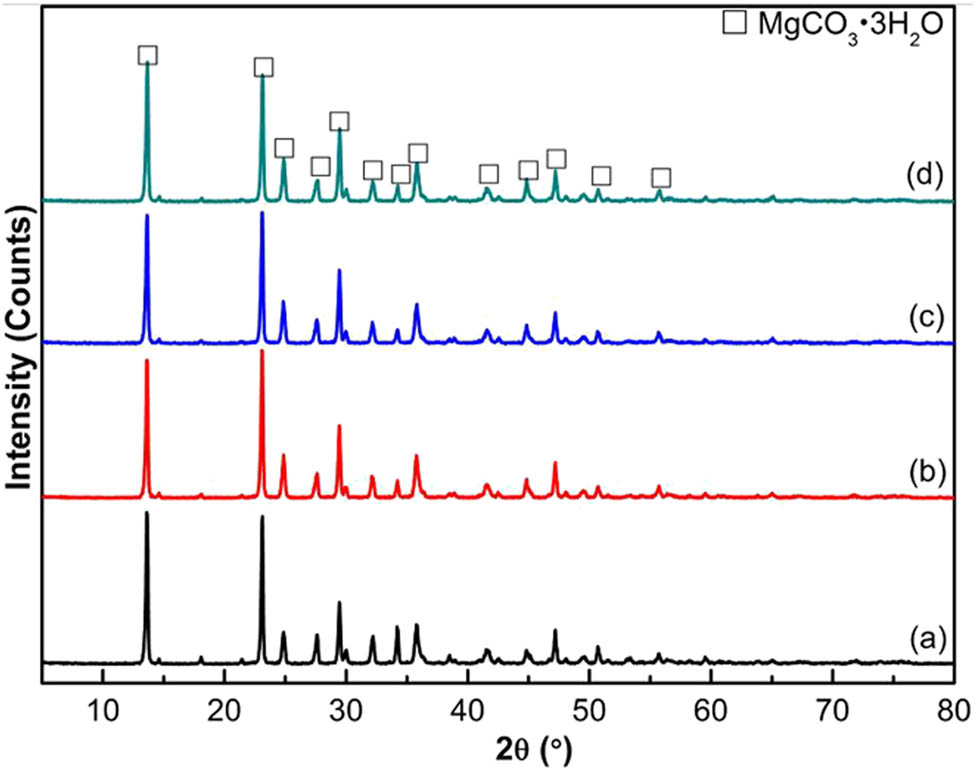
XRD patterns for the carbonation products from different carbonation times: (a) 30 min, (b) 60 min, (c) 90 min and (d) 120 min.
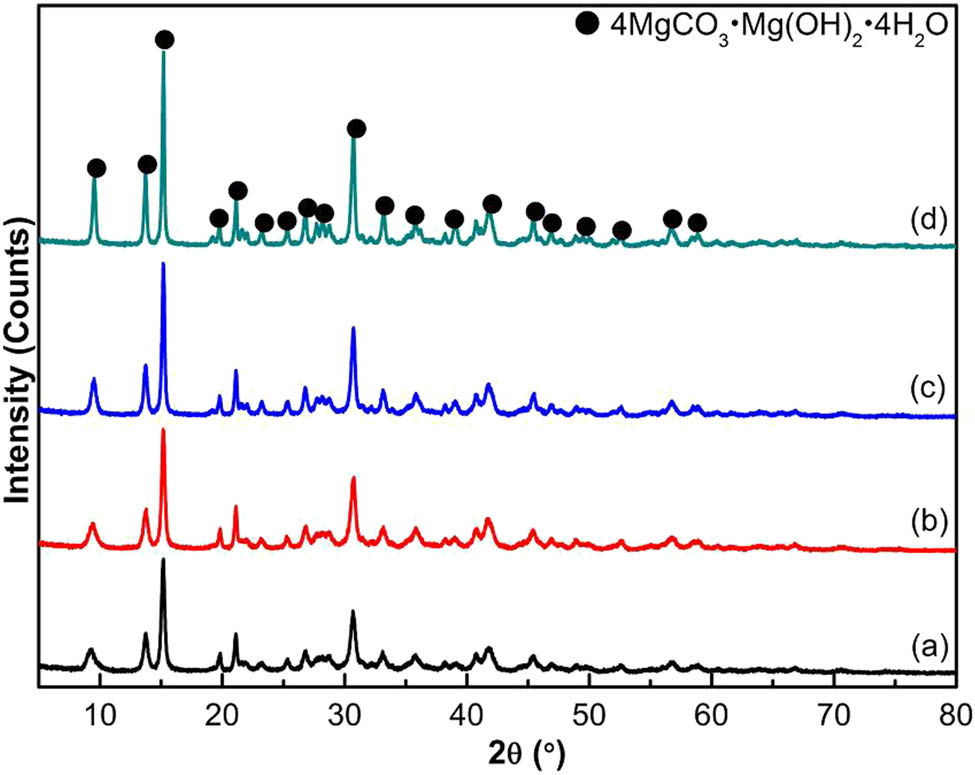
XRD patterns for the carbonation products from different aging times: (a) 1 h, (b) 4 h, (c) 8 h, and (d) 12 h.
3.4 Production mechanism
The aqueous production reaction in the gas–liquid–solid system is irreversible and heterogeneous due to the low porosity of the materials. The proposed production processes are shown in equations (1)–(6). First, ammonia reacts with magnesium chloride to form magnesium hydroxide [27], which then forms magnesium bicarbonate through reaction with carbon dioxide. Magnesium bicarbonate then forms into nesquehonite in solution with aging. Nesquehonite converted to dypingite (4MgCO3·Mg(OH)2·8H2O, 4MgCO3·Mg(OH)2·5H2O) and hydromagnesite with different aging temperatures.
During carbonation with gypsum desulfurization [28], ammonia was used to generate ammonium bicarbonate (or carbonate). The two systems have different reaction mechanisms. Based on the above analysis, the following three-step mechanism of talc carbonation can be summarized: (a) Mg2+ is leached from pristine talc, (b) magnesium chloride is transformed into magnesium hydroxide via reaction with ammonia, and (c) to magnesium carbonate hydrate with different polymorph and morphology forms via reaction with CO2 (g) injected in the solution and magnesium hydroxide (Figure 10).
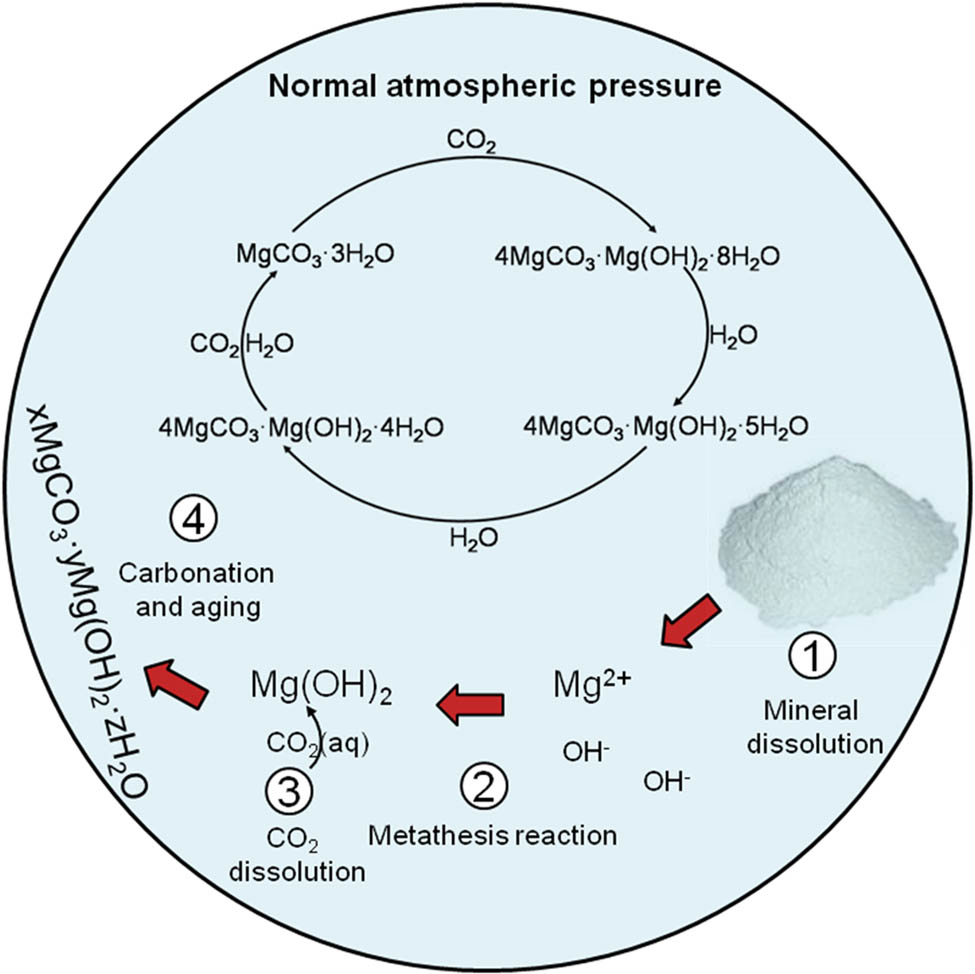
Schematic diagram of the production of magnesium carbonate hydrate with different morphologies during talc carbonation.
4 Conclusions
We demonstrated a facile route for the production of magnesium carbonate hydrate with talc as a raw material. Main productions and results were as follows: (1) magnesium carbonate hydrate can display four different morphologies during the reaction process, (2) at reaction temperatures (including carbonation temperature and aging temperature) below 80°C, the magnesium carbonate hydrate particles were all prone to assemble into needle-like morphology, which had a formula of MgCO3·3H2O, the size and growth situation of the needle-like particle can be adjusted by the reaction time, (3) at reaction temperatures (including carbonation temperature and aging temperature) above 80°C, the sheet-like structure was the preferred morphology, and it had a formula of 4MgCO3·Mg(OH)2·8H2O; with an further increase of reaction temperature, the sheet-like structure would transfer into different layer-like particles, such as rose-like and nest-like particles. The method of the synthesis of magnesium carbonate hydrate described here may serve a promising basis for systemically studying the application of the mineral carbonation product for CO2 sequestration.
Acknowledgments
This work was supported by the doctoral foundation of Southwest University of Science and Technology (17zx7117), the Longshan academic talent research, and the Innovation Team Project of SWUST (18lzx401).
Conflict of interest: The authors declare no conflict of interest.
References
[1] Zhang H, Chang Z, Qian X, An X. In situ preparation, characterization and performance of magnesium carbonate whiskers/cellulose fibers hybrid paper. Cellulose. 2014;21(6):4633–41.10.1007/s10570-014-0462-5Search in Google Scholar
[2] Zajac M, Durdzinski P, Stabler C, Skocek J, Nied D, Ben Haha M. Influence of calcium and magnesium carbonates on hydration kinetics, hydrate assemblage and microstructural development of metakaolin containing composite cements. Cement Concrete Res. 2018;106:91–102.10.1016/j.cemconres.2018.01.008Search in Google Scholar
[3] Zhang Z, Zheng Y, Ni Y, Liu Z, Chen J, Liang X. Temperature- and pH-dependent morphology and FT-IR analysis of magnesium carbonate hydrates. J Phys Chem B. 2006;110(26):12969–73.10.1021/jp061261jSearch in Google Scholar PubMed
[4] Wang D, Xu L, Nai J, Bai X, Sun T. Morphology-controllable synthesis of nanocarbons and their application in advanced symmetric supercapacitor in ionic liquid electrolyte. Appl Surf Sci. 2019;473:1014–23.10.1016/j.apsusc.2018.12.256Search in Google Scholar
[5] Gautier Q, Bénézeth P, Mavromatis V, Schott J. Hydromagnesite solubility product and growth kinetics in aqueous solution from 25 to 75°C. Geochim Cosmochim Acta. 2014;138:1–20.10.1016/j.gca.2014.03.044Search in Google Scholar
[6] Guo M, Li Q, Ye X, Wu Z. Magnesium carbonate precipitation under the influence of polyacrylamide. Powder Technol. 2010;200(1–2):46–51.10.1016/j.powtec.2010.02.006Search in Google Scholar
[7] Wu J, Yan H, Zhang X, Wei L, Liu X, Xu B. Magnesium hydroxide nanoparticles synthesized in water-in-oil microemulsions. J Colloid Interface Sci. 2008;324(1–2):167–71.10.1016/j.jcis.2008.03.052Search in Google Scholar PubMed
[8] Wang Y, Li Z, Demopoulos GP. Controlled precipitation of nesquehonite (MgCO3·3H2O) by the reaction of MgCl2 with (NH4)2CO3. J Cryst Growth. 2008;310(6):1220–7.10.1016/j.jcrysgro.2008.01.002Search in Google Scholar
[9] Mitsuhashi K, Tagami N, Tanabe K, Ohkubo T, Sakai H, Koishi M, et al. Synthesis of microtubes with a surface of “house of cards” structure via needlelike particles and control of their pore size. Langmuir. 2005;21(8):3659–63.10.1021/la047580oSearch in Google Scholar PubMed
[10] Yan C, Xue D. Novel self-assembled MgO nanosheet and its precursors. J Phys Chem B. 2005;109(25):12358–61.10.1021/jp050644zSearch in Google Scholar PubMed
[11] Li Q, Ding Y, Yu GH, Li C, Li FQ, Qian YT. Fabrication of light-emitting porous hydromagnesite with rosette-like architecture. Solid State Commun. 2003;125(2):117–20.10.1016/S0038-1098(02)00710-XSearch in Google Scholar
[12] Tábi T, Suplicz A, Czigány T, Kovacs JG. Thermal and mechanical analysis of injection moulded poly(lactic acid) filled with poly(ethylene glycol) and talc. J Therm Anal Calorim. 2014;118(3):1419–30.10.1007/s10973-014-4037-3Search in Google Scholar
[13] Rane RH, Jayaraman K, Nichols KL, Bieler TR, Mazor MH. Evolution of crystalline orientation and texture during solid phase die-drawing of PP-talc composites. J Polym Sci Part B Polym Phys. 2014;52(23):1528–38.10.1002/polb.23592Search in Google Scholar
[14] Li G, Tavangarian F. Sintering behavior, microstructure and mechanical properties of vacuum sintered SiC/spinel nanocomposite. J Alloys Compd. 2014;615:204–10.10.1016/j.jallcom.2014.06.173Search in Google Scholar
[15] Yu W, Wang X, Ferraris E, Zhang J. Melt crystallization of PLA/Talc in fused filament fabrication. Mater Des. 2019;182:1–6.10.1016/j.matdes.2019.108013Search in Google Scholar
[16] Llewelyn G, Rees A, Griffiths CA, Jacobi M. A novel hybrid foaming method for low-pressure microcellular foam production of unfilled and talc-filled copolymer polypropylenes. Polymers. 2019;11(11):1–15.10.3390/polym11111896Search in Google Scholar PubMed PubMed Central
[17] Lima LCB, Coelho CC, Silva FC, Meneguin AB, Barud HS, Bezerra RDS, et al. Hybrid systems based on talc and chitosan for controlled drug release. Materials. 2019;12(21):1–17.10.3390/ma12213634Search in Google Scholar PubMed PubMed Central
[18] Ghanbari A, Behzadfar E, Arjmand M. Properties of talc filled reactor-made thermoplastic polyolefin composites. J Polym Res. 2019;26(10):1–8.10.1007/s10965-019-1902-6Search in Google Scholar
[19] Ding W, Ouyang J, Yang H. Synthesis and characterization of nesquehonite (MgCO3·3H2O) powders from natural talc. Powder Technol. 2016;292:169–75.10.1016/j.powtec.2016.01.037Search in Google Scholar
[20] Ding W, Yang H, Ouyang J, Long H. Modified wollastonite sequestrating CO2 and exploratory application of the carbonation products. RSC Adv. 2016;6(81):78090–9.10.1039/C6RA13908FSearch in Google Scholar
[21] Ding W, Fu L, Ouyang J, Yang H. CO2 mineral sequestration by wollastonite carbonation. Phys Chem Min. 2014;41(7):489–96.10.1007/s00269-014-0659-zSearch in Google Scholar
[22] Montes-Hernandez G, Renard F, Chiriac R, Findling N, Toche F. Rapid precipitation of magnesite microcrystals from Mg(OH)2–H2O–CO2 slurry enhanced by NaOH and a heat-aging step (from ∼20 to 90°C). Cryst Growth Des. 2012;12(11):5233–40.10.1021/cg300652sSearch in Google Scholar
[23] Harrison AL, Mavromatis V, Oelkers EH, Benezeth P. Solubility of the hydrated Mg-carbonates nesquehonite and dypingite from 5 to 35 degrees C: implications for CO2 storage and the relative stability of Mg-carbonates. Chem Geol. 2019;504:123–35.10.1016/j.chemgeo.2018.11.003Search in Google Scholar
[24] Oelkers EH, Berninger U-N, Perez-Fernandez A, Chmeleff J, Mavromatis V. The temporal evolution of magnesium isotope fractionation during hydromagnesite dissolution, precipitation, and at equilibrium. Geochim Cosmochim Acta. 2018;226:36–49.10.1016/j.gca.2017.11.004Search in Google Scholar
[25] Zhang ZP, Zheng YJ, Zhang JX, Zhang Q, Chen JP, Liu ZM, et al. Synthesis and shape evolution of monodisperse basic magnesium carbonate microspheres. Cryst Growth Des. 2007;7(2):337–42.10.1021/cg060544ySearch in Google Scholar
[26] Giester G, Lengauer CL, Rieck B. The crystal structure of nesquehonite, MgCO3·3H2O, from Lavrion, Greece. Min Petrol. 2000;70(3–4):153–63.10.1007/s007100070001Search in Google Scholar
[27] Ding W, Chen Q, Sun H, Peng T. Modified phosphogypsum sequestrating CO2 and characteristics of the carbonation product. Energy. 2019;182:224–35.10.1016/j.energy.2019.05.220Search in Google Scholar
[28] Ding W, Yang H, Ouyang J. Mineral carbonation of a desulfurization residue for CO2 sequestration. RSC Adv. 2015;5(82):67184–94.10.1039/C5RA10576ESearch in Google Scholar
© 2020 Qiuju Chen et al., published by De Gruyter
This work is licensed under the Creative Commons Attribution 4.0 International License.
Articles in the same Issue
- Regular Articles
- Electrochemical antioxidant screening and evaluation based on guanine and chitosan immobilized MoS2 nanosheet modified glassy carbon electrode (guanine/CS/MoS2/GCE)
- Kinetic models of the extraction of vanillic acid from pumpkin seeds
- On the maximum ABC index of bipartite graphs without pendent vertices
- Estimation of the total antioxidant potential in the meat samples using thin-layer chromatography
- Molecular dynamics simulation of sI methane hydrate under compression and tension
- Spatial distribution and potential ecological risk assessment of some trace elements in sediments and grey mangrove (Avicennia marina) along the Arabian Gulf coast, Saudi Arabia
- Amino-functionalized graphene oxide for Cr(VI), Cu(II), Pb(II) and Cd(II) removal from industrial wastewater
- Chemical composition and in vitro activity of Origanum vulgare L., Satureja hortensis L., Thymus serpyllum L. and Thymus vulgaris L. essential oils towards oral isolates of Candida albicans and Candida glabrata
- Effect of excess Fluoride consumption on Urine-Serum Fluorides, Dental state and Thyroid Hormones among children in “Talab Sarai” Punjab Pakistan
- Design, Synthesis and Characterization of Novel Isoxazole Tagged Indole Hybrid Compounds
- Comparison of kinetic and enzymatic properties of intracellular phosphoserine aminotransferases from alkaliphilic and neutralophilic bacteria
- Green Organic Solvent-Free Oxidation of Alkylarenes with tert-Butyl Hydroperoxide Catalyzed by Water-Soluble Copper Complex
- Ducrosia ismaelis Asch. essential oil: chemical composition profile and anticancer, antimicrobial and antioxidant potential assessment
- DFT calculations as an efficient tool for prediction of Raman and infra-red spectra and activities of newly synthesized cathinones
- Influence of Chemical Osmosis on Solute Transport and Fluid Velocity in Clay Soils
- A New fatty acid and some triterpenoids from propolis of Nkambe (North-West Region, Cameroon) and evaluation of the antiradical scavenging activity of their extracts
- Antiplasmodial Activity of Stigmastane Steroids from Dryobalanops oblongifolia Stem Bark
- Rapid identification of direct-acting pancreatic protectants from Cyclocarya paliurus leaves tea by the method of serum pharmacochemistry combined with target cell extraction
- Immobilization of Pseudomonas aeruginosa static biomass on eggshell powder for on-line preconcentration and determination of Cr (VI)
- Assessment of methyl 2-({[(4,6-dimethoxypyrimidin-2-yl)carbamoyl] sulfamoyl}methyl)benzoate through biotic and abiotic degradation modes
- Stability of natural polyphenol fisetin in eye drops Stability of fisetin in eye drops
- Production of a bioflocculant by using activated sludge and its application in Pb(II) removal from aqueous solution
- Molecular Properties of Carbon Crystal Cubic Structures
- Synthesis and characterization of calcium carbonate whisker from yellow phosphorus slag
- Study on the interaction between catechin and cholesterol by the density functional theory
- Analysis of some pharmaceuticals in the presence of their synthetic impurities by applying hybrid micelle liquid chromatography
- Two mixed-ligand coordination polymers based on 2,5-thiophenedicarboxylic acid and flexible N-donor ligands: the protective effect on periodontitis via reducing the release of IL-1β and TNF-α
- Incorporation of silver stearate nanoparticles in methacrylate polymeric monoliths for hemeprotein isolation
- Development of ultrasound-assisted dispersive solid-phase microextraction based on mesoporous carbon coated with silica@iron oxide nanocomposite for preconcentration of Te and Tl in natural water systems
- N,N′-Bis[2-hydroxynaphthylidene]/[2-methoxybenzylidene]amino]oxamides and their divalent manganese complexes: Isolation, spectral characterization, morphology, antibacterial and cytotoxicity against leukemia cells
- Determination of the content of selected trace elements in Polish commercial fruit juices and health risk assessment
- Diorganotin(iv) benzyldithiocarbamate complexes: synthesis, characterization, and thermal and cytotoxicity study
- Keratin 17 is induced in prurigo nodularis lesions
- Anticancer, antioxidant, and acute toxicity studies of a Saudi polyherbal formulation, PHF5
- LaCoO3 perovskite-type catalysts in syngas conversion
- Comparative studies of two vegetal extracts from Stokesia laevis and Geranium pratense: polyphenol profile, cytotoxic effect and antiproliferative activity
- Fragmentation pattern of certain isatin–indole antiproliferative conjugates with application to identify their in vitro metabolic profiles in rat liver microsomes by liquid chromatography tandem mass spectrometry
- Investigation of polyphenol profile, antioxidant activity and hepatoprotective potential of Aconogonon alpinum (All.) Schur roots
- Lead discovery of a guanidinyl tryptophan derivative on amyloid cascade inhibition
- Physicochemical evaluation of the fruit pulp of Opuntia spp growing in the Mediterranean area under hard climate conditions
- Electronic structural properties of amino/hydroxyl functionalized imidazolium-based bromide ionic liquids
- New Schiff bases of 2-(quinolin-8-yloxy)acetohydrazide and their Cu(ii), and Zn(ii) metal complexes: their in vitro antimicrobial potentials and in silico physicochemical and pharmacokinetics properties
- Treatment of adhesions after Achilles tendon injury using focused ultrasound with targeted bFGF plasmid-loaded cationic microbubbles
- Synthesis of orotic acid derivatives and their effects on stem cell proliferation
- Chirality of β2-agonists. An overview of pharmacological activity, stereoselective analysis, and synthesis
- Fe3O4@urea/HITh-SO3H as an efficient and reusable catalyst for the solvent-free synthesis of 7-aryl-8H-benzo[h]indeno[1,2-b]quinoline-8-one and indeno[2′,1′:5,6]pyrido[2,3-d]pyrimidine derivatives
- Adsorption kinetic characteristics of molybdenum in yellow-brown soil in response to pH and phosphate
- Enhancement of thermal properties of bio-based microcapsules intended for textile applications
- Exploring the effect of khat (Catha edulis) chewing on the pharmacokinetics of the antiplatelet drug clopidogrel in rats using the newly developed LC-MS/MS technique
- A green strategy for obtaining anthraquinones from Rheum tanguticum by subcritical water
- Cadmium (Cd) chloride affects the nutrient uptake and Cd-resistant bacterium reduces the adsorption of Cd in muskmelon plants
- Removal of H2S by vermicompost biofilter and analysis on bacterial community
- Structural cytotoxicity relationship of 2-phenoxy(thiomethyl)pyridotriazolopyrimidines: Quantum chemical calculations and statistical analysis
- A self-breaking supramolecular plugging system as lost circulation material in oilfield
- Synthesis, characterization, and pharmacological evaluation of thiourea derivatives
- Application of drug–metal ion interaction principle in conductometric determination of imatinib, sorafenib, gefitinib and bosutinib
- Synthesis and characterization of a novel chitosan-grafted-polyorthoethylaniline biocomposite and utilization for dye removal from water
- Optimisation of urine sample preparation for shotgun proteomics
- DFT investigations on arylsulphonyl pyrazole derivatives as potential ligands of selected kinases
- Treatment of Parkinson’s disease using focused ultrasound with GDNF retrovirus-loaded microbubbles to open the blood–brain barrier
- New derivatives of a natural nordentatin
- Fluorescence biomarkers of malignant melanoma detectable in urine
- Study of the remediation effects of passivation materials on Pb-contaminated soil
- Saliva proteomic analysis reveals possible biomarkers of renal cell carcinoma
- Withania frutescens: Chemical characterization, analgesic, anti-inflammatory, and healing activities
- Design, synthesis and pharmacological profile of (−)-verbenone hydrazones
- Synthesis of magnesium carbonate hydrate from natural talc
- Stability-indicating HPLC-DAD assay for simultaneous quantification of hydrocortisone 21 acetate, dexamethasone, and fluocinolone acetonide in cosmetics
- A novel lactose biosensor based on electrochemically synthesized 3,4-ethylenedioxythiophene/thiophene (EDOT/Th) copolymer
- Citrullus colocynthis (L.) Schrad: Chemical characterization, scavenging and cytotoxic activities
- Development and validation of a high performance liquid chromatography/diode array detection method for estrogen determination: Application to residual analysis in meat products
- PCSK9 concentrations in different stages of subclinical atherosclerosis and their relationship with inflammation
- Development of trace analysis for alkyl methanesulfonates in the delgocitinib drug substance using GC-FID and liquid–liquid extraction with ionic liquid
- Electrochemical evaluation of the antioxidant capacity of natural compounds on glassy carbon electrode modified with guanine-, polythionine-, and nitrogen-doped graphene
- A Dy(iii)–organic framework as a fluorescent probe for highly selective detection of picric acid and treatment activity on human lung cancer cells
- A Zn(ii)–organic cage with semirigid ligand for solvent-free cyanosilylation and inhibitory effect on ovarian cancer cell migration and invasion ability via regulating mi-RNA16 expression
- Polyphenol content and antioxidant activities of Prunus padus L. and Prunus serotina L. leaves: Electrochemical and spectrophotometric approach and their antimicrobial properties
- The combined use of GC, PDSC and FT-IR techniques to characterize fat extracted from commercial complete dry pet food for adult cats
- MALDI-TOF MS profiling in the discovery and identification of salivary proteomic patterns of temporomandibular joint disorders
- Concentrations of dioxins, furans and dioxin-like PCBs in natural animal feed additives
- Structure and some physicochemical and functional properties of water treated under ammonia with low-temperature low-pressure glow plasma of low frequency
- Mesoscale nanoparticles encapsulated with emodin for targeting antifibrosis in animal models
- Amine-functionalized magnetic activated carbon as an adsorbent for preconcentration and determination of acidic drugs in environmental water samples using HPLC-DAD
- Antioxidant activity as a response to cadmium pollution in three durum wheat genotypes differing in salt-tolerance
- A promising naphthoquinone [8-hydroxy-2-(2-thienylcarbonyl)naphtho[2,3-b]thiophene-4,9-dione] exerts anti-colorectal cancer activity through ferroptosis and inhibition of MAPK signaling pathway based on RNA sequencing
- Synthesis and efficacy of herbicidal ionic liquids with chlorsulfuron as the anion
- Effect of isovalent substitution on the crystal structure and properties of two-slab indates BaLa2−xSmxIn2O7
- Synthesis, spectral and thermo-kinetics explorations of Schiff-base derived metal complexes
- An improved reduction method for phase stability testing in the single-phase region
- Comparative analysis of chemical composition of some commercially important fishes with an emphasis on various Malaysian diets
- Development of a solventless stir bar sorptive extraction/thermal desorption large volume injection capillary gas chromatographic-mass spectrometric method for ultra-trace determination of pyrethroids pesticides in river and tap water samples
- A turbidity sensor development based on NL-PI observers: Experimental application to the control of a Sinaloa’s River Spirulina maxima cultivation
- Deep desulfurization of sintering flue gas in iron and steel works based on low-temperature oxidation
- Investigations of metallic elements and phenolics in Chinese medicinal plants
- Influence of site-classification approach on geochemical background values
- Effects of ageing on the surface characteristics and Cu(ii) adsorption behaviour of rice husk biochar in soil
- Adsorption and sugarcane-bagasse-derived activated carbon-based mitigation of 1-[2-(2-chloroethoxy)phenyl]sulfonyl-3-(4-methoxy-6-methyl-1,3,5-triazin-2-yl) urea-contaminated soils
- Antimicrobial and antifungal activities of bifunctional cooper(ii) complexes with non-steroidal anti-inflammatory drugs, flufenamic, mefenamic and tolfenamic acids and 1,10-phenanthroline
- Application of selenium and silicon to alleviate short-term drought stress in French marigold (Tagetes patula L.) as a model plant species
- Screening and analysis of xanthine oxidase inhibitors in jute leaves and their protective effects against hydrogen peroxide-induced oxidative stress in cells
- Synthesis and physicochemical studies of a series of mixed-ligand transition metal complexes and their molecular docking investigations against Coronavirus main protease
- A study of in vitro metabolism and cytotoxicity of mephedrone and methoxetamine in human and pig liver models using GC/MS and LC/MS analyses
- A new phenyl alkyl ester and a new combretin triterpene derivative from Combretum fragrans F. Hoffm (Combretaceae) and antiproliferative activity
- Erratum
- Erratum to: A one-step incubation ELISA kit for rapid determination of dibutyl phthalate in water, beverage and liquor
- Review Articles
- Sinoporphyrin sodium, a novel sensitizer for photodynamic and sonodynamic therapy
- Natural products isolated from Casimiroa
- Plant description, phytochemical constituents and bioactivities of Syzygium genus: A review
- Evaluation of elastomeric heat shielding materials as insulators for solid propellant rocket motors: A short review
- Special Issue on Applied Biochemistry and Biotechnology 2019
- An overview of Monascus fermentation processes for monacolin K production
- Study on online soft sensor method of total sugar content in chlorotetracycline fermentation tank
- Studies on the Anti-Gouty Arthritis and Anti-hyperuricemia Properties of Astilbin in Animal Models
- Effects of organic fertilizer on water use, photosynthetic characteristics, and fruit quality of pear jujube in northern Shaanxi
- Characteristics of the root exudate release system of typical plants in plateau lakeside wetland under phosphorus stress conditions
- Characterization of soil water by the means of hydrogen and oxygen isotope ratio at dry-wet season under different soil layers in the dry-hot valley of Jinsha River
- Composition and diurnal variation of floral scent emission in Rosa rugosa Thunb. and Tulipa gesneriana L.
- Preparation of a novel ginkgolide B niosomal composite drug
- The degradation, biodegradability and toxicity evaluation of sulfamethazine antibiotics by gamma radiation
- Special issue on Monitoring, Risk Assessment and Sustainable Management for the Exposure to Environmental Toxins
- Insight into the cadmium and zinc binding potential of humic acids derived from composts by EEM spectra combined with PARAFAC analysis
- Source apportionment of soil contamination based on multivariate receptor and robust geostatistics in a typical rural–urban area, Wuhan city, middle China
- Special Issue on 13th JCC 2018
- The Role of H2C2O4 and Na2CO3 as Precipitating Agents on The Physichochemical Properties and Photocatalytic Activity of Bismuth Oxide
- Preparation of magnetite-silica–cetyltrimethylammonium for phenol removal based on adsolubilization
- Topical Issue on Agriculture
- Size-dependent growth kinetics of struvite crystals in wastewater with calcium ions
- The effect of silica-calcite sedimentary rock contained in the chicken broiler diet on the overall quality of chicken muscles
- Physicochemical properties of selected herbicidal products containing nicosulfuron as an active ingredient
- Lycopene in tomatoes and tomato products
- Fluorescence in the assessment of the share of a key component in the mixing of feed
- Sulfur application alleviates chromium stress in maize and wheat
- Effectiveness of removal of sulphur compounds from the air after 3 years of biofiltration with a mixture of compost soil, peat, coconut fibre and oak bark
- Special Issue on the 4th Green Chemistry 2018
- Study and fire test of banana fibre reinforced composites with flame retardance properties
- Special Issue on the International conference CosCI 2018
- Disintegration, In vitro Dissolution, and Drug Release Kinetics Profiles of k-Carrageenan-based Nutraceutical Hard-shell Capsules Containing Salicylamide
- Synthesis of amorphous aluminosilicate from impure Indonesian kaolin
- Special Issue on the International Conf on Science, Applied Science, Teaching and Education 2019
- Functionalization of Congo red dye as a light harvester on solar cell
- The effect of nitrite food preservatives added to se’i meat on the expression of wild-type p53 protein
- Biocompatibility and osteoconductivity of scaffold porous composite collagen–hydroxyapatite based coral for bone regeneration
- Special Issue on the Joint Science Congress of Materials and Polymers (ISCMP 2019)
- Effect of natural boron mineral use on the essential oil ratio and components of Musk Sage (Salvia sclarea L.)
- A theoretical and experimental study of the adsorptive removal of hexavalent chromium ions using graphene oxide as an adsorbent
- A study on the bacterial adhesion of Streptococcus mutans in various dental ceramics: In vitro study
- Corrosion study of copper in aqueous sulfuric acid solution in the presence of (2E,5E)-2,5-dibenzylidenecyclopentanone and (2E,5E)-bis[(4-dimethylamino)benzylidene]cyclopentanone: Experimental and theoretical study
- Special Issue on Chemistry Today for Tomorrow 2019
- Diabetes mellitus type 2: Exploratory data analysis based on clinical reading
- Multivariate analysis for the classification of copper–lead and copper–zinc glasses
- Special Issue on Advances in Chemistry and Polymers
- The spatial and temporal distribution of cationic and anionic radicals in early embryo implantation
- Special Issue on 3rd IC3PE 2020
- Magnetic iron oxide/clay nanocomposites for adsorption and catalytic oxidation in water treatment applications
- Special Issue on IC3PE 2018/2019 Conference
- Exergy analysis of conventional and hydrothermal liquefaction–esterification processes of microalgae for biodiesel production
- Advancing biodiesel production from microalgae Spirulina sp. by a simultaneous extraction–transesterification process using palm oil as a co-solvent of methanol
- Topical Issue on Applications of Mathematics in Chemistry
- Omega and the related counting polynomials of some chemical structures
- M-polynomial and topological indices of zigzag edge coronoid fused by starphene
Articles in the same Issue
- Regular Articles
- Electrochemical antioxidant screening and evaluation based on guanine and chitosan immobilized MoS2 nanosheet modified glassy carbon electrode (guanine/CS/MoS2/GCE)
- Kinetic models of the extraction of vanillic acid from pumpkin seeds
- On the maximum ABC index of bipartite graphs without pendent vertices
- Estimation of the total antioxidant potential in the meat samples using thin-layer chromatography
- Molecular dynamics simulation of sI methane hydrate under compression and tension
- Spatial distribution and potential ecological risk assessment of some trace elements in sediments and grey mangrove (Avicennia marina) along the Arabian Gulf coast, Saudi Arabia
- Amino-functionalized graphene oxide for Cr(VI), Cu(II), Pb(II) and Cd(II) removal from industrial wastewater
- Chemical composition and in vitro activity of Origanum vulgare L., Satureja hortensis L., Thymus serpyllum L. and Thymus vulgaris L. essential oils towards oral isolates of Candida albicans and Candida glabrata
- Effect of excess Fluoride consumption on Urine-Serum Fluorides, Dental state and Thyroid Hormones among children in “Talab Sarai” Punjab Pakistan
- Design, Synthesis and Characterization of Novel Isoxazole Tagged Indole Hybrid Compounds
- Comparison of kinetic and enzymatic properties of intracellular phosphoserine aminotransferases from alkaliphilic and neutralophilic bacteria
- Green Organic Solvent-Free Oxidation of Alkylarenes with tert-Butyl Hydroperoxide Catalyzed by Water-Soluble Copper Complex
- Ducrosia ismaelis Asch. essential oil: chemical composition profile and anticancer, antimicrobial and antioxidant potential assessment
- DFT calculations as an efficient tool for prediction of Raman and infra-red spectra and activities of newly synthesized cathinones
- Influence of Chemical Osmosis on Solute Transport and Fluid Velocity in Clay Soils
- A New fatty acid and some triterpenoids from propolis of Nkambe (North-West Region, Cameroon) and evaluation of the antiradical scavenging activity of their extracts
- Antiplasmodial Activity of Stigmastane Steroids from Dryobalanops oblongifolia Stem Bark
- Rapid identification of direct-acting pancreatic protectants from Cyclocarya paliurus leaves tea by the method of serum pharmacochemistry combined with target cell extraction
- Immobilization of Pseudomonas aeruginosa static biomass on eggshell powder for on-line preconcentration and determination of Cr (VI)
- Assessment of methyl 2-({[(4,6-dimethoxypyrimidin-2-yl)carbamoyl] sulfamoyl}methyl)benzoate through biotic and abiotic degradation modes
- Stability of natural polyphenol fisetin in eye drops Stability of fisetin in eye drops
- Production of a bioflocculant by using activated sludge and its application in Pb(II) removal from aqueous solution
- Molecular Properties of Carbon Crystal Cubic Structures
- Synthesis and characterization of calcium carbonate whisker from yellow phosphorus slag
- Study on the interaction between catechin and cholesterol by the density functional theory
- Analysis of some pharmaceuticals in the presence of their synthetic impurities by applying hybrid micelle liquid chromatography
- Two mixed-ligand coordination polymers based on 2,5-thiophenedicarboxylic acid and flexible N-donor ligands: the protective effect on periodontitis via reducing the release of IL-1β and TNF-α
- Incorporation of silver stearate nanoparticles in methacrylate polymeric monoliths for hemeprotein isolation
- Development of ultrasound-assisted dispersive solid-phase microextraction based on mesoporous carbon coated with silica@iron oxide nanocomposite for preconcentration of Te and Tl in natural water systems
- N,N′-Bis[2-hydroxynaphthylidene]/[2-methoxybenzylidene]amino]oxamides and their divalent manganese complexes: Isolation, spectral characterization, morphology, antibacterial and cytotoxicity against leukemia cells
- Determination of the content of selected trace elements in Polish commercial fruit juices and health risk assessment
- Diorganotin(iv) benzyldithiocarbamate complexes: synthesis, characterization, and thermal and cytotoxicity study
- Keratin 17 is induced in prurigo nodularis lesions
- Anticancer, antioxidant, and acute toxicity studies of a Saudi polyherbal formulation, PHF5
- LaCoO3 perovskite-type catalysts in syngas conversion
- Comparative studies of two vegetal extracts from Stokesia laevis and Geranium pratense: polyphenol profile, cytotoxic effect and antiproliferative activity
- Fragmentation pattern of certain isatin–indole antiproliferative conjugates with application to identify their in vitro metabolic profiles in rat liver microsomes by liquid chromatography tandem mass spectrometry
- Investigation of polyphenol profile, antioxidant activity and hepatoprotective potential of Aconogonon alpinum (All.) Schur roots
- Lead discovery of a guanidinyl tryptophan derivative on amyloid cascade inhibition
- Physicochemical evaluation of the fruit pulp of Opuntia spp growing in the Mediterranean area under hard climate conditions
- Electronic structural properties of amino/hydroxyl functionalized imidazolium-based bromide ionic liquids
- New Schiff bases of 2-(quinolin-8-yloxy)acetohydrazide and their Cu(ii), and Zn(ii) metal complexes: their in vitro antimicrobial potentials and in silico physicochemical and pharmacokinetics properties
- Treatment of adhesions after Achilles tendon injury using focused ultrasound with targeted bFGF plasmid-loaded cationic microbubbles
- Synthesis of orotic acid derivatives and their effects on stem cell proliferation
- Chirality of β2-agonists. An overview of pharmacological activity, stereoselective analysis, and synthesis
- Fe3O4@urea/HITh-SO3H as an efficient and reusable catalyst for the solvent-free synthesis of 7-aryl-8H-benzo[h]indeno[1,2-b]quinoline-8-one and indeno[2′,1′:5,6]pyrido[2,3-d]pyrimidine derivatives
- Adsorption kinetic characteristics of molybdenum in yellow-brown soil in response to pH and phosphate
- Enhancement of thermal properties of bio-based microcapsules intended for textile applications
- Exploring the effect of khat (Catha edulis) chewing on the pharmacokinetics of the antiplatelet drug clopidogrel in rats using the newly developed LC-MS/MS technique
- A green strategy for obtaining anthraquinones from Rheum tanguticum by subcritical water
- Cadmium (Cd) chloride affects the nutrient uptake and Cd-resistant bacterium reduces the adsorption of Cd in muskmelon plants
- Removal of H2S by vermicompost biofilter and analysis on bacterial community
- Structural cytotoxicity relationship of 2-phenoxy(thiomethyl)pyridotriazolopyrimidines: Quantum chemical calculations and statistical analysis
- A self-breaking supramolecular plugging system as lost circulation material in oilfield
- Synthesis, characterization, and pharmacological evaluation of thiourea derivatives
- Application of drug–metal ion interaction principle in conductometric determination of imatinib, sorafenib, gefitinib and bosutinib
- Synthesis and characterization of a novel chitosan-grafted-polyorthoethylaniline biocomposite and utilization for dye removal from water
- Optimisation of urine sample preparation for shotgun proteomics
- DFT investigations on arylsulphonyl pyrazole derivatives as potential ligands of selected kinases
- Treatment of Parkinson’s disease using focused ultrasound with GDNF retrovirus-loaded microbubbles to open the blood–brain barrier
- New derivatives of a natural nordentatin
- Fluorescence biomarkers of malignant melanoma detectable in urine
- Study of the remediation effects of passivation materials on Pb-contaminated soil
- Saliva proteomic analysis reveals possible biomarkers of renal cell carcinoma
- Withania frutescens: Chemical characterization, analgesic, anti-inflammatory, and healing activities
- Design, synthesis and pharmacological profile of (−)-verbenone hydrazones
- Synthesis of magnesium carbonate hydrate from natural talc
- Stability-indicating HPLC-DAD assay for simultaneous quantification of hydrocortisone 21 acetate, dexamethasone, and fluocinolone acetonide in cosmetics
- A novel lactose biosensor based on electrochemically synthesized 3,4-ethylenedioxythiophene/thiophene (EDOT/Th) copolymer
- Citrullus colocynthis (L.) Schrad: Chemical characterization, scavenging and cytotoxic activities
- Development and validation of a high performance liquid chromatography/diode array detection method for estrogen determination: Application to residual analysis in meat products
- PCSK9 concentrations in different stages of subclinical atherosclerosis and their relationship with inflammation
- Development of trace analysis for alkyl methanesulfonates in the delgocitinib drug substance using GC-FID and liquid–liquid extraction with ionic liquid
- Electrochemical evaluation of the antioxidant capacity of natural compounds on glassy carbon electrode modified with guanine-, polythionine-, and nitrogen-doped graphene
- A Dy(iii)–organic framework as a fluorescent probe for highly selective detection of picric acid and treatment activity on human lung cancer cells
- A Zn(ii)–organic cage with semirigid ligand for solvent-free cyanosilylation and inhibitory effect on ovarian cancer cell migration and invasion ability via regulating mi-RNA16 expression
- Polyphenol content and antioxidant activities of Prunus padus L. and Prunus serotina L. leaves: Electrochemical and spectrophotometric approach and their antimicrobial properties
- The combined use of GC, PDSC and FT-IR techniques to characterize fat extracted from commercial complete dry pet food for adult cats
- MALDI-TOF MS profiling in the discovery and identification of salivary proteomic patterns of temporomandibular joint disorders
- Concentrations of dioxins, furans and dioxin-like PCBs in natural animal feed additives
- Structure and some physicochemical and functional properties of water treated under ammonia with low-temperature low-pressure glow plasma of low frequency
- Mesoscale nanoparticles encapsulated with emodin for targeting antifibrosis in animal models
- Amine-functionalized magnetic activated carbon as an adsorbent for preconcentration and determination of acidic drugs in environmental water samples using HPLC-DAD
- Antioxidant activity as a response to cadmium pollution in three durum wheat genotypes differing in salt-tolerance
- A promising naphthoquinone [8-hydroxy-2-(2-thienylcarbonyl)naphtho[2,3-b]thiophene-4,9-dione] exerts anti-colorectal cancer activity through ferroptosis and inhibition of MAPK signaling pathway based on RNA sequencing
- Synthesis and efficacy of herbicidal ionic liquids with chlorsulfuron as the anion
- Effect of isovalent substitution on the crystal structure and properties of two-slab indates BaLa2−xSmxIn2O7
- Synthesis, spectral and thermo-kinetics explorations of Schiff-base derived metal complexes
- An improved reduction method for phase stability testing in the single-phase region
- Comparative analysis of chemical composition of some commercially important fishes with an emphasis on various Malaysian diets
- Development of a solventless stir bar sorptive extraction/thermal desorption large volume injection capillary gas chromatographic-mass spectrometric method for ultra-trace determination of pyrethroids pesticides in river and tap water samples
- A turbidity sensor development based on NL-PI observers: Experimental application to the control of a Sinaloa’s River Spirulina maxima cultivation
- Deep desulfurization of sintering flue gas in iron and steel works based on low-temperature oxidation
- Investigations of metallic elements and phenolics in Chinese medicinal plants
- Influence of site-classification approach on geochemical background values
- Effects of ageing on the surface characteristics and Cu(ii) adsorption behaviour of rice husk biochar in soil
- Adsorption and sugarcane-bagasse-derived activated carbon-based mitigation of 1-[2-(2-chloroethoxy)phenyl]sulfonyl-3-(4-methoxy-6-methyl-1,3,5-triazin-2-yl) urea-contaminated soils
- Antimicrobial and antifungal activities of bifunctional cooper(ii) complexes with non-steroidal anti-inflammatory drugs, flufenamic, mefenamic and tolfenamic acids and 1,10-phenanthroline
- Application of selenium and silicon to alleviate short-term drought stress in French marigold (Tagetes patula L.) as a model plant species
- Screening and analysis of xanthine oxidase inhibitors in jute leaves and their protective effects against hydrogen peroxide-induced oxidative stress in cells
- Synthesis and physicochemical studies of a series of mixed-ligand transition metal complexes and their molecular docking investigations against Coronavirus main protease
- A study of in vitro metabolism and cytotoxicity of mephedrone and methoxetamine in human and pig liver models using GC/MS and LC/MS analyses
- A new phenyl alkyl ester and a new combretin triterpene derivative from Combretum fragrans F. Hoffm (Combretaceae) and antiproliferative activity
- Erratum
- Erratum to: A one-step incubation ELISA kit for rapid determination of dibutyl phthalate in water, beverage and liquor
- Review Articles
- Sinoporphyrin sodium, a novel sensitizer for photodynamic and sonodynamic therapy
- Natural products isolated from Casimiroa
- Plant description, phytochemical constituents and bioactivities of Syzygium genus: A review
- Evaluation of elastomeric heat shielding materials as insulators for solid propellant rocket motors: A short review
- Special Issue on Applied Biochemistry and Biotechnology 2019
- An overview of Monascus fermentation processes for monacolin K production
- Study on online soft sensor method of total sugar content in chlorotetracycline fermentation tank
- Studies on the Anti-Gouty Arthritis and Anti-hyperuricemia Properties of Astilbin in Animal Models
- Effects of organic fertilizer on water use, photosynthetic characteristics, and fruit quality of pear jujube in northern Shaanxi
- Characteristics of the root exudate release system of typical plants in plateau lakeside wetland under phosphorus stress conditions
- Characterization of soil water by the means of hydrogen and oxygen isotope ratio at dry-wet season under different soil layers in the dry-hot valley of Jinsha River
- Composition and diurnal variation of floral scent emission in Rosa rugosa Thunb. and Tulipa gesneriana L.
- Preparation of a novel ginkgolide B niosomal composite drug
- The degradation, biodegradability and toxicity evaluation of sulfamethazine antibiotics by gamma radiation
- Special issue on Monitoring, Risk Assessment and Sustainable Management for the Exposure to Environmental Toxins
- Insight into the cadmium and zinc binding potential of humic acids derived from composts by EEM spectra combined with PARAFAC analysis
- Source apportionment of soil contamination based on multivariate receptor and robust geostatistics in a typical rural–urban area, Wuhan city, middle China
- Special Issue on 13th JCC 2018
- The Role of H2C2O4 and Na2CO3 as Precipitating Agents on The Physichochemical Properties and Photocatalytic Activity of Bismuth Oxide
- Preparation of magnetite-silica–cetyltrimethylammonium for phenol removal based on adsolubilization
- Topical Issue on Agriculture
- Size-dependent growth kinetics of struvite crystals in wastewater with calcium ions
- The effect of silica-calcite sedimentary rock contained in the chicken broiler diet on the overall quality of chicken muscles
- Physicochemical properties of selected herbicidal products containing nicosulfuron as an active ingredient
- Lycopene in tomatoes and tomato products
- Fluorescence in the assessment of the share of a key component in the mixing of feed
- Sulfur application alleviates chromium stress in maize and wheat
- Effectiveness of removal of sulphur compounds from the air after 3 years of biofiltration with a mixture of compost soil, peat, coconut fibre and oak bark
- Special Issue on the 4th Green Chemistry 2018
- Study and fire test of banana fibre reinforced composites with flame retardance properties
- Special Issue on the International conference CosCI 2018
- Disintegration, In vitro Dissolution, and Drug Release Kinetics Profiles of k-Carrageenan-based Nutraceutical Hard-shell Capsules Containing Salicylamide
- Synthesis of amorphous aluminosilicate from impure Indonesian kaolin
- Special Issue on the International Conf on Science, Applied Science, Teaching and Education 2019
- Functionalization of Congo red dye as a light harvester on solar cell
- The effect of nitrite food preservatives added to se’i meat on the expression of wild-type p53 protein
- Biocompatibility and osteoconductivity of scaffold porous composite collagen–hydroxyapatite based coral for bone regeneration
- Special Issue on the Joint Science Congress of Materials and Polymers (ISCMP 2019)
- Effect of natural boron mineral use on the essential oil ratio and components of Musk Sage (Salvia sclarea L.)
- A theoretical and experimental study of the adsorptive removal of hexavalent chromium ions using graphene oxide as an adsorbent
- A study on the bacterial adhesion of Streptococcus mutans in various dental ceramics: In vitro study
- Corrosion study of copper in aqueous sulfuric acid solution in the presence of (2E,5E)-2,5-dibenzylidenecyclopentanone and (2E,5E)-bis[(4-dimethylamino)benzylidene]cyclopentanone: Experimental and theoretical study
- Special Issue on Chemistry Today for Tomorrow 2019
- Diabetes mellitus type 2: Exploratory data analysis based on clinical reading
- Multivariate analysis for the classification of copper–lead and copper–zinc glasses
- Special Issue on Advances in Chemistry and Polymers
- The spatial and temporal distribution of cationic and anionic radicals in early embryo implantation
- Special Issue on 3rd IC3PE 2020
- Magnetic iron oxide/clay nanocomposites for adsorption and catalytic oxidation in water treatment applications
- Special Issue on IC3PE 2018/2019 Conference
- Exergy analysis of conventional and hydrothermal liquefaction–esterification processes of microalgae for biodiesel production
- Advancing biodiesel production from microalgae Spirulina sp. by a simultaneous extraction–transesterification process using palm oil as a co-solvent of methanol
- Topical Issue on Applications of Mathematics in Chemistry
- Omega and the related counting polynomials of some chemical structures
- M-polynomial and topological indices of zigzag edge coronoid fused by starphene

